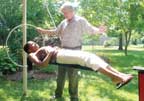|
|
 |
||||||||
|
Volume 13, Issue 30 ~ July 29 - August 3, 2005
|
|||||||||

|
Trekking through mud all in a day’s work for young biologists by Carol Mock with Carrie Steele When 13-year-old Michelle Denny’s shoe got sucked off in the mud, she didn’t mind. She knew that hungry ground came with the territory for amphibian hunters. Searching muddy creeks and trails for species of frogs and salamanders was a daily routine. Covered with mud and minus a sneaker, she returned home late in the afternoon, a tired young biologist. Denny was one of 25 gifted and talented middle school students who signed on to take part in the four-year-old Maryland Summer Center for Aquatic Research’s second amphibian study. Their job was to count amphibians on the grounds of the American Chestnut Land Trust in Port Republic, which manages some 3,000 acres to preserve Calvert County’s natural and cultural resources. “It was cool because we went into the woods to look,” said 12-year-old Amy Gionfriddo, of Calvert’s Southern Middle School. “We also learned to use GPS. We don’t do this in school.” To become a young biologist at the Maryland Summer Center for Aquatic Research, some 50 applicants submitted their grades, recommendations and a written composition. Only half of those middle-schoolers were chosen to hike along streams and trek through mud in search of their subject: frogs and toads, newts and salamanders. “The students met with a Maryland Department of Natural Resources biologist, a land manager from the Land Trust and a Geographic Information Systems expert,” said Calvert County teacher Tom Harten. The Aquatic Research Center was one of 17 such centers around the state, with other centers focusing on music, dance, engineering among other topics. Each is sponsored by Maryland State Department of Education and a county school board. In Calvert County, students studied amphibian surveys from Jug Bay and other sites, framed their research methods and predicted what they would find. Then, just like scientists all over the world, they made their hypothesis: a search at the American Chestnut Land Trust would yield six or more amphibian species on their predicted list. In their two weeks’ work, students confirmed their hypothesis. “We found nine different species,” said Calvert Southern Middle-Schooler Denny. Students caught 99 frogs, toads newts and salamanders from three Land Trust locations, using five different methods. Remember picking up an old board and seeing the scattering of assorted slimy, scaly and hairy creatures? Students did too, placing 120 cover boards on the ground two months before their study. But this method turned out to be the least successful of the five.
The most successful way to find a frog was to walk down the trail and count amphibians that could be seen or heard. By this visual-encounter survey method, students found the most amphibians. In the stream-survey method, students scooped up amphibians with a net in a 15-meter-by-two-meter transect. The student-scientists also tried to find the amphibians without boundaries and within a time limit. Finally, they used data loggers to record different amphibian calls and to record activity at night. Five different frog calls were identified from the recorded data. “This is the first time I’ve been able to identify a frog on the first guess,” said 12-year-old Dillon Thatcher, also from Southern Middle School. Sometimes hearing frogs was easier than catching them. “We used our hands or nets to catch the frogs. Sometimes you almost lost a shoe,” said Will Spann, a seventh-grader from Northern Middle School, who was one of the lucky students who kept his shoes on. “It was sort of easy but they kept hopping away,” added 11-year-old classmate Kelly Bolen. While students scoured sites for amphibians, others studied the habitat. Young scientists waded in to collect data on pH, water temperature, air temperature, dissolved oxygen, stream speed and sky conditions, explained Bolen. Good water quality is necessary to sustain amphibian numbers and diversity. According to 12-year-old Spann, the results of the tests were all within normal range. “If the stream is too fast, the eggs can get washed away or crushed,” he said. “Also if the pH is too low it can burn through their skin.” Amphibian survival, students discovered, has everything to do with water quality — and the environment. “We learned the causes for amphibian decline,” said Gionfriddo. Poor water quality is often to blame for low numbers of amphibians. But there’s also harm coming from above. “Ozone, global warming and ultraviolet rays are all really hard on them,” she added. Indeed, amphibians everywhere are in decline, reflecting trouble for the bigger environmental picture. Yet the young biologists found more species than they had expected, tracking six of their 10 predicted species, plus another three not on the guest list. Among the final count were 54 green frogs, three pickerel frogs, six bullfrogs, 20 Fowler’s toads, six southern leopard frogs and one Cope’s gray tree frog; plus their unpredicted five spring peepers, one red-spotted newt and one spotted salamander.
Even a magician can’t make clutter disappear by Mark Burns Captain Token comes up from his rummage through banana boxes with a small armload of curiosities. Bringing them to the center of the tent, he lays out his finds atop a bright red steamer trunk and starts haggling. A novelty Danger sign is his for a dollar, but the disembodied silicone hand raises questions. “Five bucks? Really?” Token flops the hand about in midair, eyeing it skeptically. “Alright, deal,” he says, dejectedly. “You know, the way I’m looking at it is a buck a finger,” says Wayne Alan, the hand’s present owner. He takes the hand and bends the middle finger toward the palm. “Well, you don’t want to buy that one, do you? You know, you’re right. I’m only gonna charge you $4.” They close the hand deal, make a quick bargain for a trick necktie, and Captain Token drifts into deliberation with fellow magicians over whether the wand is still able to belch fire. One Magician’s Old Tricks Such were the finds in the Riva backyard of Wayne Alan on a July Saturday. In one sense the gathering was unremarkable. Friends chatted over Shasta and cheese; Alan accepted a compliment for his intelligent logistics, having sorted the smaller items into boxes according to price points. But his Magician’s Yard Sale, touted as the world’s first, presented a most unusual menagerie: Magical cabinets, levitation devices, stage props, a sprawl of mannequin fragments and random illusionary knick-knackery set discreetly under tent for browsing. Some 30 magicians from Virginia to New Jersey — only card-carrying pros were allowed — filtered past a check-in table and through the tent over the course of three hours, looking for bargains to spice up their acts. Alan bounced among them, touting his items’ stageworthiness and chatting with friends. At points he broke away to demonstrate stage illusions, chopping his neighbor’s daughter in three or levitating her a few feet off the ground. With the girl back safely to earth in one piece, Alan returned to conversation over the tip-over trunk that magically produces a person or props. It’s already gone to Captain Token for $900.
But the joke’s on Alan. “You know what the funny thing is?” he asked. “The first guy that bought anything sold me $200 of stuff.” Another Magician’s Treasures It seems Alan’s now about to clear more space. Annapolis magician Jack Julius and wife/assistant Tanya Butchick are intrigued by the zig-zag — a coveted stage illusion that signals the big time. Julius shuts his spouse into a gilded red cabinet, slices her in three with flat, wide blades and shunts her midsection into open space. A showman’s flourish later, Butchick is realigned to exit unscathed, torso reunited with shimmering silver hot pants. A flawless first attempt, and another piece sold. Dick Swanddy, 76, of New Jersey, watches from the side as Julius and Butchick try out their new magic. Not much for shopping today, Swanddy is content to mingle and help explain some of the illusions to shopping magicians. He’s an old-schooler who got his start in magic by reading Blackstone comic books and trying out the tricks in the centerfold. Swanddy’s been in the Society of American Magicians for 55 years and performing even longer. “I grew up in a small town in South Dakota, so I didn’t have any exposure to any of this stuff,” he says, gesturing toward the zig-zag and other stage illusions. “I don’t go for the box stuff, the big stuff. Too much to lug around.” Swanddy, who now performs gratis for non-profits, prefers close-up and stand-up work, demonstrating his smooth slight of hand by disappearing a coin and finding it behind the limb of a tree beside him. Meanwhile, Captain Token is browsing. His true name is Louis Hofheimer, 43, of Alexandria. The stage name was adopted for his first gig in 1984: While working at Chuck E. Cheese’s, he did a game show and magic act in the downtime between parties. Now he takes a break to introduce himself, offering his business card with a bit of prestidigitation. “I’ve got my magic business on side one; and on side two, my card; and my Hofheimer security on side three. It’s one of those three-sided inks they make nowadays. Yeah. That’s the ticket.” Home security is Hofheimer’s nine-to-five but magic his moonlight; he figures he only breaks even with the latter. It’s his hope that today’s finds — especially the tip-over trunk — will make his act bigger and better. The tent event is winding down when Eric and Dwight Redman, a father-son duo out of Bladensburg, arrive to check out the gear. Eric, 20, has been performing magic from age five. His dad, Dwight, 55, is a bit newer as his assistant. “I’ve been in it about five years,” the father says. “After dragging around with him for 10.” They’ve spotted a levitating chair illusion, just beyond the scimitars lying in the grass near tent’s edge, and are busy searching its secrets. Eric is a fresh face among magicians here, a newbie despite his early experience. He can’t stay long to mingle, though, as he’s soon off again to pursue his career, due for a performance later today in Richmond. As the Redmans leave, Hofheimer shuffles through his car’s back seat and sizes up its trunk. He’s made Alan’s day, and now his act may have grown too big for his car. Mark Burns began writing for Bay Weekly as an intern in 1998 and worked several years as calendar editor and staff writer. While studying at University of Maryland, he contributes movie reviews, most recently The Wedding Crashers on July 21. |
||||||||
|
|
|||||||||
|
© COPYRIGHT 2004 by New Bay Enterprises, Inc. All rights reserved.
|

 The Girl in the Band
The Girl in the Band Mama-Palooza
Mama-Palooza


